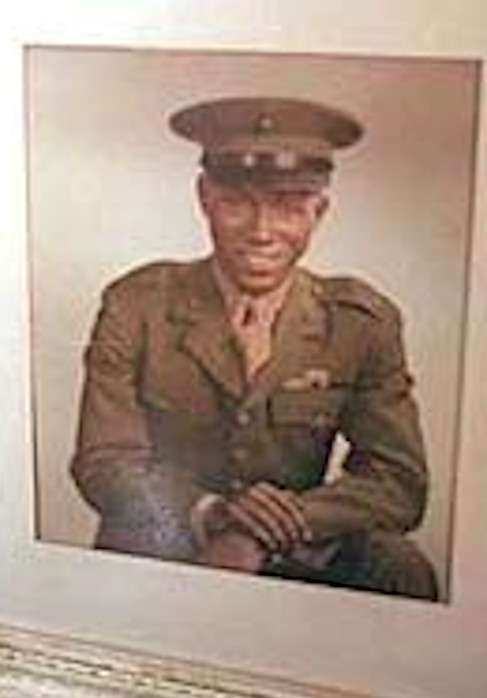BRANCH-FREDERICK
FREDERICK CLINTON BRANCH

CAPT

FIRST AFRICAN-AMERICAN OFFICER IN THE MARINE CORPS
In June 1941, President Roosevelt signed Executive Order-8802 that prohibited racial discrimination by any government agency. Prior to this time African-Americans had been barred from Marine Corps service and the President's order opened it to their enrollment for the first time. The Commandant of the Marine Corps told the Secretary of the Navy, Frank Knox, There would be a definite loss of efficiency in the Marine Corps if we have to take Negroes. Secretary Knox disagreed and instructed the Commandant to carry out the President's order. Although some leaders of the Corps strongly resented the directive, objecting to civilian interference in matters concerning military effectiveness and morale, recruiting began on June 1, 1942 after a policy letter was issued identifying a quota of 900 colored recruits. Black recruits were enlisted as Class III(c), Marine Corps Reserve, and their record book was stamped COLORED.
Frederick Clinton Branch was born on May 31, 1922, in Hamlet, NC, the fourth of seven sons of an African Methodist Episcopal Zion minister. He graduated from high school in Mamaroneck, NY, and studied at Johnson C. Smith University in Charlotte before transferring to Temple University in Philadelphia where he was drafted in May 1943 and assigned to the Marine Corps. As was the procedure at the time, Branch was sent for recruit training to segregated Montford Point Camp, five miles from the white recruits training at Camp Lejeune, NC, and he thus became known as a Montford Point Marine. While training under white officers at Montford Point Camp he applied for Officer Candidate School but was turned down. He later recalled, I read all the requirements to be an officer and nowhere in there did it say anything about race. In a 1995 interview Branch said, They told me to shut that blanket-blank stuff up about being an officer. You ain't going to be no officer. Later, while serving with the 51st Defense Battalion in the South Pacific during World War II, he earned the notice of his commanding colonel with his starched uniform and conscientious manner. When he learned Branch had been rejected for Officer Candidate School he reportedly said, Well Branch, if you keep up the good work, I'll approve it. It has been reported that the colonel personally lobbied officials in Washington on Branch's behalf.
In 1944, Branch received the recommendation he had been promised and he was sent to the Navy's V-12 program at Purdue University, the only African-American in a class of 250 future officers. While there he clearly learned that discrimination continued to exist in the Marine Corp although he said in an interview that he did not face any flak during training at all, but he fully understood the difficulty of being a black man in America before the civil rights era. In a 1997 interview he recalled that while at Purdue he refused an usher's request to go to a theater balcony where African-Americans were expected to sit. The usher went away but returned telling Branch he was wanted on the telephone. He said, It was my commanding officer. He said, 'Branch, your liberty's up. Get back to your dormitory.'
Branch excelled at Purdue and made the dean's list. On November 10, 1945, he was commissioned as a 2NDLT and became the first African-American commissioned officer in Marine Corps history, a significant milestone in the then 170-year history of the Corps. Six other black candidates had entered the Marine's officer training program before this date but all had been eliminated for one reason or another. With the war ended by the time he was commissioned, Branch went into the Reserves. Reactivated during the Korean War, he was sent to Camp Pendleton in California, in command of an antiaircraft training platoon. In the 1997 interview he said, The Marine Corps had envisioned black officers for black troops. As it turned out, my first command had one Negro and 79 whites. Discharged in 1952, he returned to the Reserves. In a 1999 interview he said that he became disillusioned by continuing covert discrimination and promises of advanced training that never materialized so he resigned his commission in 1956, having attained the rank of Captain.
Branch earned a bachelor's degree in physics when he graduated from Temple University. He became a high school teacher at Murrell Dobbins High School in Philadelphia, he developed a science program and was department chairman. He retired from teaching in 1988.
In 1995, the U.S. Senate passed a resolution honoring Branch on the 50th anniversary of his commissioning. In 1997, the Marine Corps honored Branch as a pioneer in integration and a training building at Marine Officers Candidate School at Quantico, VA, was named in his honor. In 2006 the Marine Corps Recruiting Command created the Frederick C. Branch Leadership Scholarship, a NROTC program for students enrolled in historically black colleges and universities. The program awards up to 68 scholarships each year and graduates are commissioned as 2NDLT in the Marine Corps.
Branch was widowed in 2000 upon the death of his wife of 55 years and after a short illness CAPT Branch died on April 10, 2005. He was laid to rest at Quantico National Cemetery in Virginia with full military honors.
Submitted by CDR Roy A. Mosteller, USNR (Ret)

